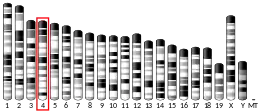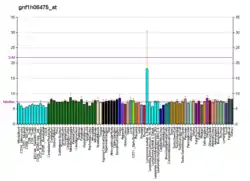TAS1R2
T1R2 - Taste receptor type 1 member 2 is a protein that in humans is encoded by the TAS1R2 gene.[5]
| TAS1R2 | |||||||||||||||||||||||||||||||||||||||||||||||||||
|---|---|---|---|---|---|---|---|---|---|---|---|---|---|---|---|---|---|---|---|---|---|---|---|---|---|---|---|---|---|---|---|---|---|---|---|---|---|---|---|---|---|---|---|---|---|---|---|---|---|---|---|
| Identifiers | |||||||||||||||||||||||||||||||||||||||||||||||||||
| Aliases | TAS1R2, GPR71, T1R2, TR2, taste 1 receptor member 2 | ||||||||||||||||||||||||||||||||||||||||||||||||||
| External IDs | OMIM: 606226 MGI: 1933546 HomoloGene: 75323 GeneCards: TAS1R2 | ||||||||||||||||||||||||||||||||||||||||||||||||||
| |||||||||||||||||||||||||||||||||||||||||||||||||||
| |||||||||||||||||||||||||||||||||||||||||||||||||||
| |||||||||||||||||||||||||||||||||||||||||||||||||||
| |||||||||||||||||||||||||||||||||||||||||||||||||||
| |||||||||||||||||||||||||||||||||||||||||||||||||||
| Wikidata | |||||||||||||||||||||||||||||||||||||||||||||||||||
| |||||||||||||||||||||||||||||||||||||||||||||||||||
The sweet taste receptor is predominantly formed as a dimer of T1R2 and T1R3 by which different organisms sense this taste. In songbirds, however, the T1R2 monomer does not exist, and they sense the sweet taste through the umami taste receptor (T1R1 and T1R3) as a result of an evolutionary change that it has undergone.[6]
Structure and molecular function
Both T1R2 and T1R3 receptors belongs to the class C G protein-coupled receptor family that features a common structure comprised a large extracellular domain, called the venus flytrap domain (VFD), which is connected to a 7-helix TMD by a cysteine-rich domain (CRD). The canonical activation mechanism of class C GPCRs follows a multiple-step process that requires communication between the VFDs (housing the orthosteric-binding site) and the TMDs via the CRDs.[7] Although , the main binding site for most sweet compounds was found to reside in the VFT domain of T1R2, the T1R2 protein is not functional without formation of the 2+3 heterodimer.[8]
Natural sweeteners interact with the orthosteric binding pocket, either of T1R2 or T1R3. The closure of the T1R2 extracellular domain involves the rotation of both T1R2 and T1R3 VFDs. The signal is then transmitted to the TMDs via the CRDs. It has also been shown that sweet proteins modulate the receptor by interacting with the CRD. Some artificial sweeteners as well as the inhibitor of the sweet taste receptor – lactisole, were shown to interact with the allosteric binding sites of one of the sub-units in the TMD.[7][9]
Another interesting quality of these receptors expressed by TAS1R2 and TAS1R1 genes, is their spontaneous activity in the absence of the extracellular domains and binding ligands.[10] This may mean that the extracellular domain regulates function of the receptor by preventing spontaneous action as well as binding to activating ligands such as sucrose.
Ligands
The T1R2+3 receptor has been shown to respond to natural sugars sucrose, sorbitol and fructose, and to the artificial sweeteners saccharin, acesulfame potassium, dulcin, guanidinoacetic acid, cyclamate, sucralose, alitame, neotame and neohesperidin dihydrochalcone (NHDC).[9] Research initially suggested that rat receptors did not respond to many other natural and artificial sugars, such as glucose and aspartame, leading to the conclusion that there must be more than one type of sweet taste receptor.[8] Contradictory evidence, however, suggested that cells expressing the human T1R2+3 receptor showed sensitivity to both aspartame and glucose but cells expressing the rat T1R2+3 receptor were only slightly activated by glucose and showed no aspartame activation.[11] These results are inconclusive about the existence of another sweet taste receptor, but show that the T1R2+3 receptors are responsible for a wide variety of different sweet tastes. Finally, T1R2+3 responses to non-sugar natural sweeteners such as steviol glycosides from the leaves of the Stevia plant and sweet proteins like thaumatin, monellin, and brazzein.[9] Another surprising ligand of the T1R2+3 is D2O, also known as heavy water which was shown to activate the human T1R2+3 receptor.[12]
Signal transduction
T1R2 and T1R1 receptors have been shown to bind to G proteins, most often the gustducin Gα subunit, although a gusducin knock-out has shown small residual activity. T1R2 and T1R1 have also been shown to activate Gαo and Gαi protein subunits.[10] This suggests that T1R1 and T1R2 are G protein-coupled receptors that inhibit adenylyl cyclases to decrease cyclic guanosine monophosphate (cGMP) levels in taste receptors.[13] Research done by creating knock-outs of common channels activated by sensory G-protein second messenger systems has also shown a connection between sweet taste perception and the phosphatidylinositol (PIP2) pathway. The nonselective cation Transient Receptor Potential channel TRPM5 has been shown to correlate with both umami and sweet taste. Also, the phospholipase PLCβ2 was shown to similarly correlate with umami and sweet taste. This suggests that activation of the G-protein pathway and subsequent activation of PLC β2 and the TRPM5 channel in these taste cells functions to activate the cell.[14]
Location and innervation
T1R2+3 expressing cells are found in circumvallate papillae and foliate papillae near the back of the tongue and palate taste receptor cells in the roof of the mouth.[8] These cells are shown to synapse upon the chorda tympani and glossopharyngeal nerves to send their signals to the brain.[15][16] T1R and T2R (bitter) channels are not expressed together in taste buds.[8]
See also
References
- GRCh38: Ensembl release 89: ENSG00000179002 - Ensembl, May 2017
- GRCm38: Ensembl release 89: ENSMUSG00000028738 - Ensembl, May 2017
- "Human PubMed Reference:". National Center for Biotechnology Information, U.S. National Library of Medicine.
- "Mouse PubMed Reference:". National Center for Biotechnology Information, U.S. National Library of Medicine.
- "Entrez Gene: TAS1R2 taste receptor, type 1, member 2".
- Toda Y, Ko MC, Liang Q, Miller ET, Rico-Guevara A, Nakagita T, et al. (July 2021). "Early origin of sweet perception in the songbird radiation". Science. 373 (6551): 226–231. Bibcode:2021Sci...373..226T. doi:10.1126/science.abf6505. PMID 34244416. S2CID 235769720.
- Chéron JB, Soohoo A, Wang Y, Golebiowski J, Antonczak S, Jiang P, Fiorucci S (May 2019). "Conserved Residues Control the T1R3-Specific Allosteric Signaling Pathway of the Mammalian Sweet-Taste Receptor". Chemical Senses. 44 (5): 303–310. doi:10.1093/chemse/bjz015. PMC 6538948. PMID 30893427.
- Nelson G, Hoon MA, Chandrashekar J, Zhang Y, Ryba NJ, Zuker CS (August 2001). "Mammalian sweet taste receptors". Cell. 106 (3): 381–390. doi:10.1016/S0092-8674(01)00451-2. PMID 11509186. S2CID 11886074.
- Behrens M (2021). "Pharmacology of TAS1R2/TAS1R3 Receptors and Sweet Taste". Handbook of Experimental Pharmacology. 275: 155–175. doi:10.1007/164_2021_438. ISBN 978-3-031-06449-4. PMID 33582884. S2CID 231927528.
- Sainz E, Cavenagh MM, LopezJimenez ND, Gutierrez JC, Battey JF, Northup JK, Sullivan SL (June 2007). "The G-protein coupling properties of the human sweet and amino acid taste receptors". Developmental Neurobiology. 67 (7): 948–959. doi:10.1002/dneu.20403. PMID 17506496. S2CID 29736077.
- Li X, Staszewski L, Xu H, Durick K, Zoller M, Adler E (April 2002). "Human receptors for sweet and umami taste". Proceedings of the National Academy of Sciences of the United States of America. 99 (7): 4692–4696. Bibcode:2002PNAS...99.4692L. doi:10.1073/pnas.072090199. PMC 123709. PMID 11917125.
- Ben Abu N, Mason PE, Klein H, Dubovski N, Ben Shoshan-Galeczki Y, Malach E, et al. (April 2021). "Sweet taste of heavy water". Communications Biology. 4 (1): 440. doi:10.1038/s42003-021-01964-y. PMC 8024362. PMID 33824405. S2CID 257085874.
- Abaffy T, Trubey KR, Chaudhari N (June 2003). "Adenylyl cyclase expression and modulation of cAMP in rat taste cells". American Journal of Physiology. Cell Physiology. 284 (6): C1420–C1428. doi:10.1152/ajpcell.00556.2002. PMID 12606315. S2CID 2704640.
- Zhang Y, Hoon MA, Chandrashekar J, Mueller KL, Cook B, Wu D, et al. (February 2003). "Coding of sweet, bitter, and umami tastes: different receptor cells sharing similar signaling pathways". Cell. 112 (3): 293–301. doi:10.1016/S0092-8674(03)00071-0. PMID 12581520. S2CID 718601.
- Beamis JF, Shapshay SM, Setzer S, Dumon JF (June 1989). "Teaching models for Nd:YAG laser bronchoscopy". Chest. 95 (6): 1316–1318. doi:10.1378/chest.95.6.1316. PMID 2721271.
- Danilova V, Hellekant G (March 2003). "Comparison of the responses of the chorda tympani and glossopharyngeal nerves to taste stimuli in C57BL/6J mice". BMC Neuroscience. 4: 5. doi:10.1186/1471-2202-4-5. PMC 153500. PMID 12617752.
Further reading
- Chandrashekar J, Hoon MA, Ryba NJ, Zuker CS (November 2006). "The receptors and cells for mammalian taste". Nature. 444 (7117): 288–294. Bibcode:2006Natur.444..288C. doi:10.1038/nature05401. PMID 17108952. S2CID 4431221.
- Hoon MA, Adler E, Lindemeier J, Battey JF, Ryba NJ, Zuker CS (February 1999). "Putative mammalian taste receptors: a class of taste-specific GPCRs with distinct topographic selectivity". Cell. 96 (4): 541–551. doi:10.1016/S0092-8674(00)80658-3. PMID 10052456. S2CID 14773710.
- Li X, Staszewski L, Xu H, Durick K, Zoller M, Adler E (April 2002). "Human receptors for sweet and umami taste". Proceedings of the National Academy of Sciences of the United States of America. 99 (7): 4692–4696. Bibcode:2002PNAS...99.4692L. doi:10.1073/pnas.072090199. PMC 123709. PMID 11917125.
- Spadaccini R, Trabucco F, Saviano G, Picone D, Crescenzi O, Tancredi T, Temussi PA (May 2003). "The mechanism of interaction of sweet proteins with the T1R2-T1R3 receptor: evidence from the solution structure of G16A-MNEI". Journal of Molecular Biology. 328 (3): 683–692. doi:10.1016/S0022-2836(03)00346-2. PMID 12706725.
- Liao J, Schultz PG (May 2003). "Three sweet receptor genes are clustered in human chromosome 1". Mammalian Genome. 14 (5): 291–301. doi:10.1007/s00335-002-2233-0. PMID 12856281. S2CID 30665284.
- Zhao GQ, Zhang Y, Hoon MA, Chandrashekar J, Erlenbach I, Ryba NJ, Zuker CS (October 2003). "The receptors for mammalian sweet and umami taste". Cell. 115 (3): 255–266. doi:10.1016/S0092-8674(03)00844-4. PMID 14636554. S2CID 11773362.
- Galindo-Cuspinera V, Winnig M, Bufe B, Meyerhof W, Breslin PA (May 2006). "A TAS1R receptor-based explanation of sweet 'water-taste'". Nature. 441 (7091): 354–357. Bibcode:2006Natur.441..354G. doi:10.1038/nature04765. PMID 16633339. S2CID 291228.
- Behrens M, Bartelt J, Reichling C, Winnig M, Kuhn C, Meyerhof W (July 2006). "Members of RTP and REEP gene families influence functional bitter taste receptor expression". The Journal of Biological Chemistry. 281 (29): 20650–20659. doi:10.1074/jbc.M513637200. PMID 16720576.
External links
This article incorporates text from the United States National Library of Medicine, which is in the public domain.




